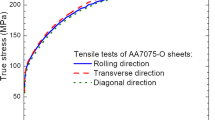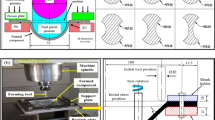Abstract
Incremental hole flanging (IHF) is a relatively new sheet metal forming process to produce intricate shapes without using dedicated punches and dies. The present work focuses on understanding the mechanics of the multi-stage IHF process through experimental studies and the finite element approach. The IHF experiments were performed on deep drawing quality steel sheets with a pre-cut hole diameter of 45 mm, 50 mm, 60 mm, and 70 mm. The cylindrical flanges were formed in four stages with an initial wall angle of 60° to a final angle 90° with an angle increment of 10° in each stage. The maximum and minimum hole expansion ratio was found to be 2.06 and 1.17 respectively. The fracture was observed in a blank of 45 mm pre-cut hole diameter in the third stage at 40 mm depth. The fracture forming limit diagram (FFLD) was determined from incrementally formed varying wall angle conical and pyramidal frustums. Consequently, six different ductile damage models incorporating Hill48 anisotropy plastic theory were successfully calibrated. The Ayyada model showed good agreement with experimental FFLD as compared to all other models. The fracture limit determined experimentally and using the Ayyada model was implemented in the finite element simulation of the IHF process to predict the formability in terms of in-plane strain distribution, forming forces, and thickness distribution. The predicted results matched accurately with the experimental data within a 6% error for all investigated conditions. Noticeably, the strain path in IHF had three deformation modes viz. plane strain, bi-axial stretching, and uni-axial tension, which was comprehended using texture analyses. Finally, irrespective of the initial pre-cut hole diameter, the surface roughness was found to decrease with the number of stages of the IHF process.

















Similar content being viewed by others
References
Kalpakjian S, Schmid SR. Manufacturing engineering and technology. 7th ed. Pearson; 2014
Dewang Y, Purohit R, Tenguria N. A study on sheet metal hole-flanging process. Mater Today Proc. 2017;4:5421–8.
Chen T-C. An analysis of forming limit in the elliptic hole-flanging process of sheet metal. J Mater Process Technol. 2007;192:373–80.
Huang J, Li S, Rao J, Zhang HM, Li XF. Study on process parameter optimization method by numerical simulation of sheet metal forming. J Chin Mech Eng. 2004;15:648–54.
Huang Y-M, Chien KH. Influence of cone semi-angle on the formability limitation of the hole-flanging process. Int J Adv Manuf Technol. 2002;19:597–606.
Thipprakmas S, Jin M, Murakawa M. Study on flanged shapes in fineblanked-hole flanging process (FB-hole flanging process) using finite element method (FEM). J Mater Process Technol. 2007;192:128–33.
Hyun DI, Oak SM, Kang SS, Moon YH. Estimation of hole flangeability for high strength steel plates. J Mater Process Technol. 2002;130:9–13.
Tang SC. Large elasto-plastic strain analysis of flanged hole forming. Comput Struct. 1981;13:363–70.
Krichen A, Kacem A, Hbaieb M. Blank-holding effect on the hole-flanging process of sheet aluminum alloy. J Mater Process Technol. 2011;211:619–26.
Stachowicz F. Estimation of hole-flange ability for deep drawing steel sheets. Arch Civ Mech Eng. 2008;8:167–72.
Huang Y-M, Chien K-H. The formability limitation of the hole-flanging process. J Mater Process Technol. 2001;117:43–51.
Takuda H, Mori K, Fujimoto H, Hatta N. Prediction of forming limit in bore-expanding of sheet metals using ductile fracture criterion. J Mater Process Technol. 1999;92:433–8.
Elbitar T, Gemeal A. Finite element analysis of deep drawing and hole flanging processing of an oil filter cover. Int J Mater Form. 2008;1:125–8.
Uthaisangsuk V, Prahl U, Bleck W. Stretch-flangeability characterisation of multiphase steel using a microstructure based failure modelling. Comput Mater Sci. 2009;45:617–23.
Comstock RJ, Scherrer DK, Adamczyk RD. Hole expansion in a variety of sheet steels. J Mater Eng Perform. 2006;15:675–83.
Adamczyk RD, Michal GM. Sheared edge extension of high-strength cold-rolled steels. J Appl Metalwork. 1986;4:157–63.
Su H, Huang L, Li J, Ma F, Ma H, Huang P, et al. Inhomogeneous deformation behaviors of oblique hole-flanging parts during electromagnetic forming. J Manuf Process. 2020;52:1–11.
Bansal A, Lingam R, Yadav SK, Reddy NV. Prediction of forming forces in single point incremental forming. J Manuf Process. 2017;28:486–93.
He A, Wang C, Liu S, Meehan PA. Switched model predictive path control of incremental sheet forming for parts with varying wall angles. J Manuf Process. 2020;53:342–55.
Raju C, Haloi N, Narayanan CS. Strain distribution and failure mode in single point incremental forming (SPIF) of multiple commercially pure aluminum sheets. J Manuf Process. 2017;30:328–35.
Min J, Kuhlenkötter B, Shu C, Störkle D, Thyssen L. Experimental and numerical investigation on incremental sheet forming with flexible die-support from metallic foam. J Manuf Process. 2018;31:605–12.
Raujol-Veillé J, Toussaint F, Tabourot L, Vautrot M, Balland P. Experimental and numerical investigation of a short, thin-walled steel tube incremental forming process. J Manuf Process. 2015;19:59–66.
Montanari L, Cristino VA, Silva MB, Martins PAF. A new approach for deformation history of material elements in hole-flanging produced by single point incremental forming. Int J Adv Manuf Technol. 2013;69:1175–83.
Cristino VA, Montanari L, Silva MB, Atkins AG, Martins PAF. Fracture in hole-flanging produced by single point incremental forming. Int J Mech Sci. 2014;83:146–54.
Cui Z, Gao L. Studies on hole-flanging process using multistage incremental forming. CIRP J Manuf Sci Technol. 2010;2:124–8.
Cao T, Lu B, Ou H, Long H, Chen J. Investigation on a new hole-flanging approach by incremental sheet forming through a featured tool. Int J Mach Tools Manuf. 2016;110:1–17.
Borrego M, Morales-Palma D, Martinez-Donaire AJ, Centeno G, Vallellano C. Experimental study of hole-flanging by single-stage incremental sheet forming. J Mater Process Technol. 2016;237:320–30.
ASTM E8/E8M-16ae1, Standard Test Methods for Tension Testing of Metallic Materials, ASTM International: West Conshohocken, PA; 2016. https://doi.org/10.1520/E0008_E0008M-16AE01(www.astm.org)
Prasad KS, Panda SK, Kar SK, Sen M, Murty SN, Sharma SC. Microstructures, forming limit and failure analyses of INCONEL 718 sheets for fabrication of aerospace components. J Mater Eng Perform. 2017;26:1513–30. https://doi.org/10.1007/s11665-017-2547-4.
Prasad KS, Panda SK, Kar SK, Singh SK, Murty SVSN, Sharma SC. Effect of temperature and deformation speed on formability of IN718 sheets: experimentation and modelling. IOP Conf Ser Mater Sci Eng. 2018. https://doi.org/10.1088/1757-899X/418/1/012055.
Elford M, Saha P, Seong D, Haque MDZ, Yoon JW. Benchmark 3-Incremental sheet forming. AIP Conf Proc. 2013;1567:227–61.
Surech K, Regalla SP. Effect of time scaling and mass scaling in numerical simulation of incremental forming. Appl Mech Mater. 2014;612:105–10.
Panicker SS, Prasad KS, Sawale G, Hazra S, Shollock B, Panda SK. Warm redrawing of AA6082 sheets and investigations into the effect of aging heat treatment on cup wall strength. Mater Sci Eng A. 2019;768:138445.
Basak S, Prasad KS, Mehto A, Bagchi J, Ganesh YS, Mohanty S, et al. Parameter optimization and texture evolution in single point incremental sheet forming process. Proc Inst Mech Eng Part B J Eng Manuf. 2019;234:126–39.
Singh SK, Limbadri K, Singh AK, Ram AM, Ravindran M, Krishna M, et al. Studies on texture and formability of Zircaloy-4 produced by pilgering route. J Mater Res Technol. 2019;8:2120–9.
Ko YK, Lee JS, Huh H, Kim HK, Park SH. Prediction of fracture in hub-hole expanding process using a new ductile fracture criterion. J Mater Process Technol. 2007;187–188:358–62.
Habibi N, Zarei-Hanzaki A, Abedi HR. An investigation into the fracture mechanisms of twinning-induced-plasticity steel sheets under various strain paths. J Mater Process Technol. 2015;224:102–16.
Prasad KS, Panda SK, Kar SK, Murty SVSN, Sharma SC. Prediction of fracture and deep drawing behavior of solution treated Inconel-718 sheets: numerical modeling and experimental validation. Mater Sci Eng A. 2018;733:393–407.
Cockcroft MG, Latham DJ. Ductility and the workability of Metals. J Inst Met. 1968;96:33–9.
Mcclintock FA. A criterion for ductile fracture by the growth of holes. J Appl Mech. 1968;363:363–71.
Ayada M. Central bursting in extrusion of inhomogeneous materials. In: Proc. 2nd Int. Conf. Technol. Plast. Stuttgart, 1987, vol. 1, 1987, p. 553–8.
Rice JR, Tracey DM. On the ductile enlargement of voids in triaxial stress fields. J Mech Phys Solids. 1969;17:201–17.
Brozzo P, Deluca B, Rendina R. A new method for the prediction of formability in metal sheets, sheet material forming and formability. Proc. Seventh Bienn. Conf. IDDRG, 1972.
Oh SI, Chen CC, Kobayashi S. Ductile fracture in axisymmetric extrusion and drawing-part 2: workability in extrusoin and drawing. J Eng Ind. 1979;101:36–44.
Basak S, Prasad KS, Sidpara AM, Panda SK. Single point incremental forming of AA6061 thin sheet: calibration of ductile fracture models incorporating anisotropy and post forming analyses. Int J Mater Form. 2019;12:623–42.
Isik K, Silva MB, Tekkaya AE, Martins PAF. Formability limits by fracture in sheet metal forming. J Mater Process Technol. 2014;214:1557–65.
Kurra S, Regalla SP. Experimental and numerical studies on formability of extra-deep drawing steel in incremental sheet metal forming. J Mater Res Technol. 2014;3:158–71.
Cristino VAM, Silva MB, Wong PK, Martins PAF. Determining the fracture forming limits in sheet metal forming: a technical note. J Strain Anal Eng Des. 2017;52:467–71.
Silva MB, Skjoedt M, Atkins AG, Bay N, Martins PAF. Single-point incremental forming and formability–failure diagrams. J Strain Anal Eng Des. 2008;43:15–35. https://doi.org/10.1243/03093247JSA340.
Leu D-K, Chen T-C, Huang Y-M. Influence of punch shapes on the collar-drawing process of sheet steel. J Mater Process Technol. 1999;88:134–46.
Masoumi M, Silva CC, Béreš M, Ladino DH, de Abreu HFG. Role of crystallographic texture on the improvement of hydrogen-induced crack resistance in API 5L X70 pipeline steel. Int J Hydrogen Energy. 2017;42:1318–26.
Prasad KS, Panda SK, Kar SK, Murty SVSN, Sharma SC. Effect of solution treatment on deep drawability of IN718 sheets: experimental analysis and metallurgical characterization. Mater Sci Eng A. 2018;727:97–112. https://doi.org/10.1016/j.msea.2018.04.110.
Masoumi M, Silva CC, de Abreu HFG. Effect of crystallographic orientations on the hydrogen-induced cracking resistance improvement of API 5L X70 pipeline steel under various thermomechanical processing. Corros Sci. 2016;111:121–31.
Funding
The work was supported by the BITS RIG grant, Project no. BITS/GAU/RIG/2017/73.
Author information
Authors and Affiliations
Corresponding author
Ethics declarations
Conflict of interest
We confirm that there are no known conflicts of interest associated with this work.
Ethical standards
The authors state that ethical standards were not violated when preparing the paper.
Additional information
Publisher's Note
Springer Nature remains neutral with regard to jurisdictional claims in published maps and institutional affiliations.
Rights and permissions
About this article
Cite this article
Gandla, P., Kurra, S., Prasad, K.S. et al. Effect of pre-cut hole diameter on deformation mechanics in multi-stage incremental hole flanging of deep drawing quality steel. Archiv.Civ.Mech.Eng 21, 16 (2021). https://doi.org/10.1007/s43452-020-00156-5
Received:
Revised:
Accepted:
Published:
DOI: https://doi.org/10.1007/s43452-020-00156-5




